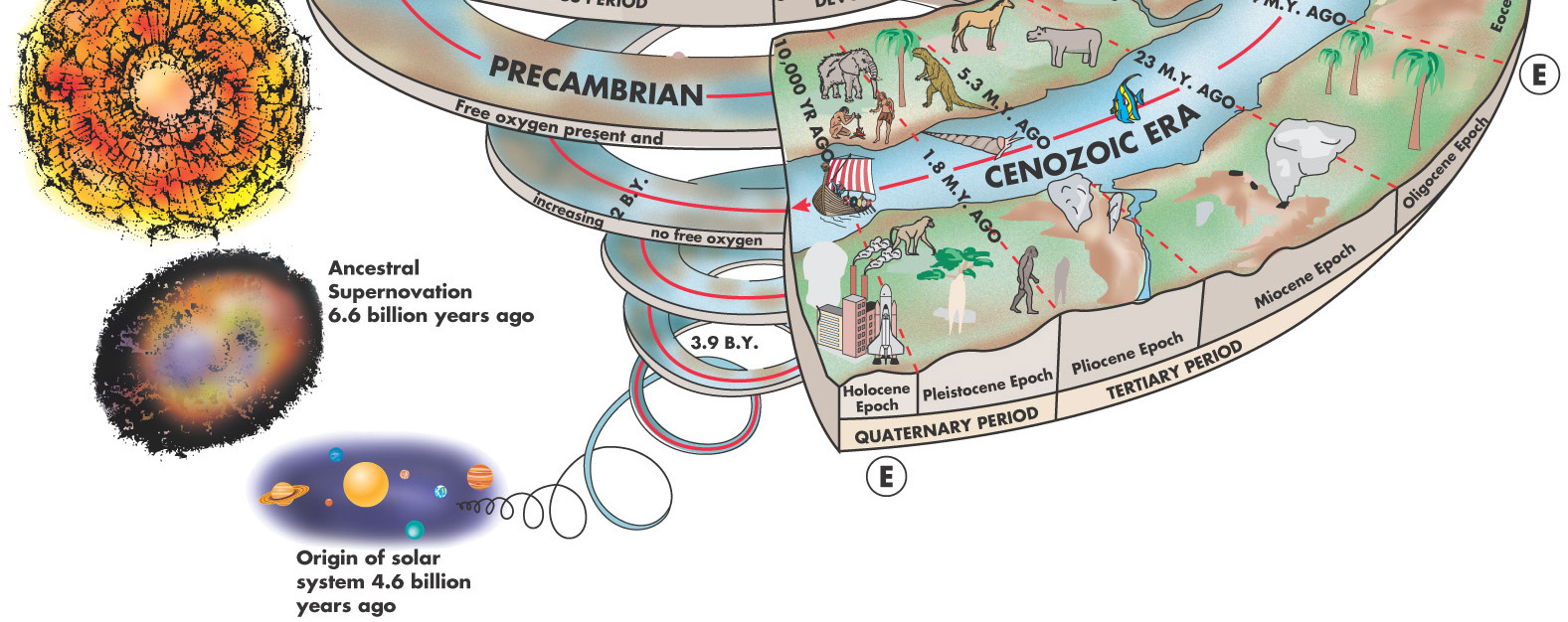

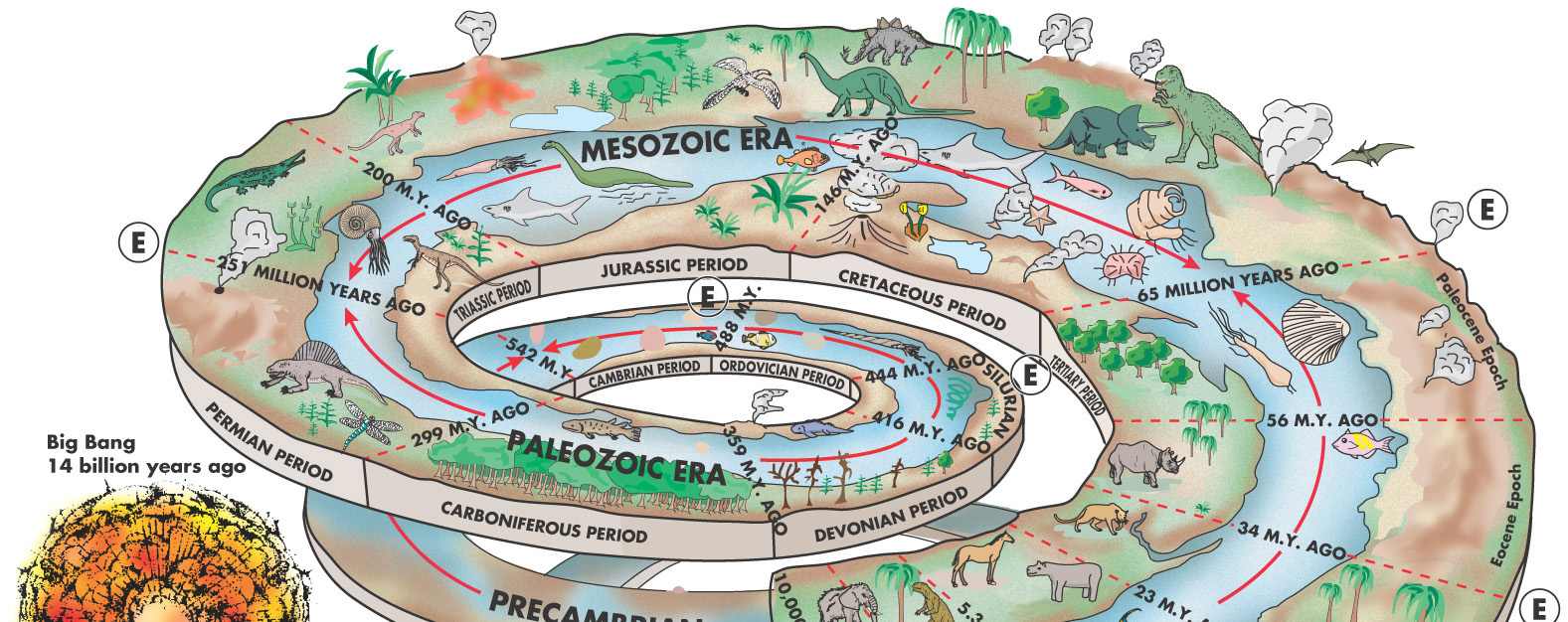
"Palaeontological research exhibits, beyond question, the phenomenon of provinces in time, as well as provinces in space. Moreover, for all our knowledge of organic remains reaches us, that species have a definite existence, and a centralization in geologic time as well as in geographical space, and that no species is repeated in time. The distribution of the individuals of fossil species also indicates their diffusion from some unique point of origin, and, consequently, goes to support the notion of their connection of these individuals through the relationship of descent, and the derivation of them all from an original protoplast." -- Chapter I, The Natural History of the European Seas (1859), Edward Forbes
"For the times they are a-changin'." -- "The Times They Are a-Changin'" (1964), Bob Dylan
BIG QUESTION: What is the broadest scale picture of Earth History?
Earth History reduced to 60 seconds:
Or, a somewhat longer take:
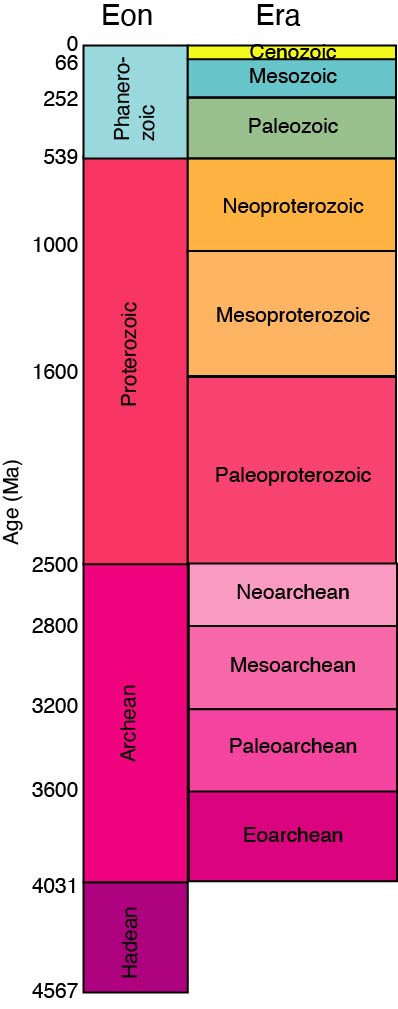
A Star Is Born: However, the VAST majority of the Solar System's mass is in the Sun. Gravitational forces of this mass starts fusing hydrogen into helium, and the Sun ignites. Originally it was dimmer than today, but still it shone. Solar wind and photon pressure began to sweep the Solar System clear of much debris.
Hadean Eon: 4.56-4.03 Ga
The Iron Catastrophe: Although the Earth is not a star, it (or at least Tellus) too went through a profound change in its earliest history. Originally the ices, organics, silicates, and metals would have been randomly mixed together, but a combination of gravitational heating, heating from impacts of planetessimals, and radioactive heating from some of the isotopes found in the silicates and metals caused the material of Tellus to melt. The heaviest materials (mostly metals, especially iron and nickel) sank to the interior to form the core; the silicates "floated" on top to form the mantle. Ices melted into gasses and liquids, and they and organics got mixed in with other material. With a metallic core, Earth now had a magnetosphere.
The Primordial Atmosphere: Tellus's original atmosphere would have mostly been hydrogen and helium, like the gas giants. However, it lost much of this atmosphere to a number of factors:
Bad Moon Rising: About 4.510 Ga, a Mars-sized planet (called "Theia" by some) collided into Tellus. Theia and a substantial fraction of Tellus' mantle was vaporized. The matter that remained in orbit around the Earth coalesced to form the Moon; the rest rained back down to the surface of the Earth. (So the matter of Tellus + Theia became redistributed to form today's Earth + Moon).
As a result of the birth of the moon:
Archean Eon: 4.03-2.50 Ga
The first Game: Prokaryote-only communities:
(Note: Archean (-EAN) refers to a part of Earth history; archaean (-AEAN) refers to a type of prokaryotic organism, and is thus a branch of the Tree of Life.)
Abiogenesis: origin of life:
The Three Domains (Bacteria, Archaea, Eukarya) and LUCA
Genetics reveals three major branches to the Tree of Life. One (the eukaryotes) contain both unicellular and multicellular forms. The other two branches--the Bacteria (sometimes called Eubacteria) and the Archaea (sometimes called the Archaeobacteria)--are all single-celled, lack nuclei, lack mitochondria, and lack chloroplasts. This condition is called the "prokaryote grade." Many are heterotrophs or are chemoautotrophs (live off of inorganic chemicals); however, some bacteria (most significantly the cyanobacteria, also called "blue green algae") are phototrophs.
Many bacteria and archaeans live in what for eukaryotes would be considered intolerable conditions: extremely high or low temperatures; very high salinities; very acid or alkali conditions; etc. These organisms are called "extremophiles," and many of them occur near the base of their respective branches of the Tree of Life. In particular, most primitive bacteria and archaeans are anaerobic environments (ones where gaseous or dissolved oxygen is lacking.)
Biologists have used this evidence to make predictions about the common ancestor of all living things (LUCA, the last universal common ancestor). This ancestor would have been single-celled and have the prokaryote grade: the eukaryote condition and (later still) multicellularity would have occurred later up the branching Tree of Life. Additionally, LUCA would likely have lived in an environment that eukaryotes would consider "extreme"; it would have definitely have been an anaerobic environment, since before the evolution of phototrophs there would have been very little free oxygen in the atmosphere. In fact, LUCA would not have been very different from some types of bacteria and archaeans today.
Bacteria (also called Eubacteria)
The other major prokaryote grade of organisms are the Archaea. These are prokaryotes; many are extremophiles; most are anaerobic. Based on features of their DNA synthesis (among others), archaeans are probably more closely related to Eukaryota than to Bacteria. It is possible that Archaea is paraphyletic with respect to Eukaryota, and that the prokaryotic ancestors of the main cell (but not the mitochondria or plastids) of eukaryotes.
Archean life would have very short food chains, but contained a great diversity of chemical pathways. Life would have been limited to the water. Most of the shallow seafloors, shores, etc. would be covered in algal/bacterial slime. As cyanobacteria spread, the oceans and atmosphere began to fill with oxygen.
Proterozoic Eon: 2.50-0.541 Ga
The Great Oxidation Event: Cyanobacteria (and eventually eukaryotic algae) release more and more oxygen into atmosphere. Between 2.7 and 2.4 Ga, most of this oxygen got absorbed by the copious levels of dissolved iron in the ocean water. This produced "rust", which accumulated on the sea floors in what is called Banded Iron Formations (or BIFs).
When the dissolved iron was all used up, BIF production stopped and the oxygen began to add to the atmosphere (and as dissolved oxygen in the water). Atmospheric levels of oxygen rises to about 10% of modern levels. The Great Oxidation Event produced the modern oxygen-nitrogen atmosphere:
The Great Oxidation Event would have devastated anaerobic organisms, which from that point onward would survive only in "extreme" environments.
New More Complex Games: In the Proterozoic we see the first evidence of the eukaryotes (Eukarya or Eukaryota). These are larger cells, with a nucleus surrounding the genetic material and many additional small structures (organelles) with specialized functions. All eukaryotes are aerobic. Many are heterotrophs, but some are autotrophic photosynthesizers (algae and plants).
Eukaryotes have mitochondria: another type of organelle that are the powerplants of the cells. Mitochondria take in food (basically the sugar glucose) and oxygen and convert it into chemical energy (the molecule adenosine triphosphate, or ATP): ATP is then used by other parts of cells as fuel. Mitochondria turn out to be descendants of alphaproteobacteria, and carry their own genome separate from the nuclear DNA of the main cell.
Additionally, plants (and a few other groups of eukaryotes) have specialized organelles called chloroplasts: these are little solar energy collectors. Chloroplasts contain the substance chlorophyll: plants use their chloroplasts to combine sunlight, water, and carbon dioxide into chemical energy and waste oxygen gas (the latter they release into the atmosphere). Similar to mitochondria, chloroplasts are descendants of once-free-living prokaryotes (in this case, cyanobacteria) incorporated into the eukaryotic cell, and retain their own DNA.
This process--the permanent incorporation of once-free-living cells into the cells of eukaryotes--has been termed endosymbiosis.The origin of eukaryotes seems to be by endosymbiosis:
Eukaryotes remain unicellular for most of the Proterozoic. Life remains entirely aquatic, but food chains get more complex with diversifying levels of heterotroph consumers and detritivores and phototroph producers.
Snowball Earth: Methane is a greenhouse gas; as it was oxidized chemically it was reduced as a component of the atmosphere, and Earth cooled. Additionally, as the continents assembed during the Proterozoic and major orogenies occurred, carbon dioxide (another major greenhouse gas) got scrubbed out of the atmosphere by chemical weathering. Several different episodes of extreme glaciation happened: the so-called Snowball Earth events. The oldest was around 2.2 Ga; the others all in the Neoproterozoic. During these times, there was glacial ice as far as the equator.
The Garden of Ediacara: (more about that in later lecture). Much of the sea floor still covered by simple algal mats. Land remains largely barren (more about this here).
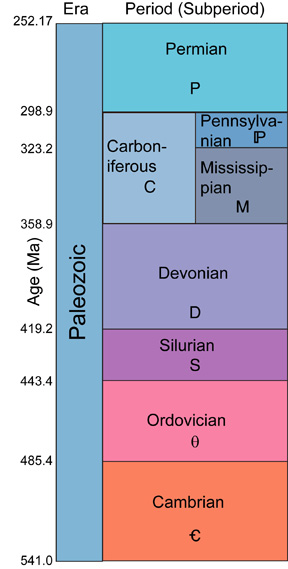
Paleozoic Era, Cambrian and Ordovician Periods (541-443 Ma):
The Cambrian Explosion: In a relatively short period of time, many different sorts of animals evolved the ability to form shells of calcium carbonate, calcium phosphate, or silica. First only very small, within a few million years they formed shells big enough to see with the naked eye: the so-called "Cambrian Explosion". (More in a later lecture.)
The Cambrian Substrate Revolution: Ecosystems became much more complex: the first burrowing animals and better grazers resulted in the loss of algal mats disappear except for extreme environments. Many diverse forms of life, but lower diversity than later seas. Many new interactions between animals and algae. First reefs (archaeocyathid sponges).
The Great Ordovician Biodiversification Event (GOBE): As early Paleozoic continues development of more diversity and more complex marine ecosystems. By end of Ordovician Period, food webs nearly (but not quite) as complex as in modern seas.
Ordovician-Silurian Mass Extinction: First major mass extinction, associated with a major glacial event and period of uplift.
Paleozoic Era, Silurian and Devonian Periods (443-359 Ma):
The New Seas: First really complex reef communities: as diverse as modern coral reefs, but different players. Food webs arguably as complex as in modern oceans, but many more types of attached motionless animals than in present seas.
Conquest of Land: Colonization of land and freshwater by green plants, various arthropods, fungi, vertebrates, and some others. Development of first soils. Plants begin to bind the soil together. Atmospheric oxygen levels increase, as there is an even larger source of photosynthesis than before. (More about this here).
Late Devonian Mass Extinctions: The second major mass extinction (really, a pair of mass extinctions separated by a few million years) saw the loss of the complex reef habitats, of primitive groups of fish, and of many diverse forms of marine invertebrates. Its trigger seems to have been eutrophication and anoxia in the shallow marine community, triggered by the new levels of nutrients flowing into the sea from the terrestrial communities (and new patterns of erosion).
Paleozoic Era, Carboniferous and Permian Periods (359-252 Ma):
The Forest Primeval: First forests and complex terrestrial and freshwater communities. Buried remains of these coal swamps form much of today's coal deposits.
Colonization of drier continental interiors. Development of seeds, wings, and shelled eggs allow plants, insects, and vertebrates (respectively) to better colonize the interiors of the continents away from lakes, streams, and swamps. Diverse terrestrial communities form.
Permo-Triassic Extinction: Tremendous global changes associated with one of the largest episodes of volcanism in Earth's history produces huge mass extinction event 542 Ma. Major players in both terrestrial and marine realms wiped out. Number of species after extinction event only about 10% what was found before hand. We'll cover this in more detail in a couple of weeks.
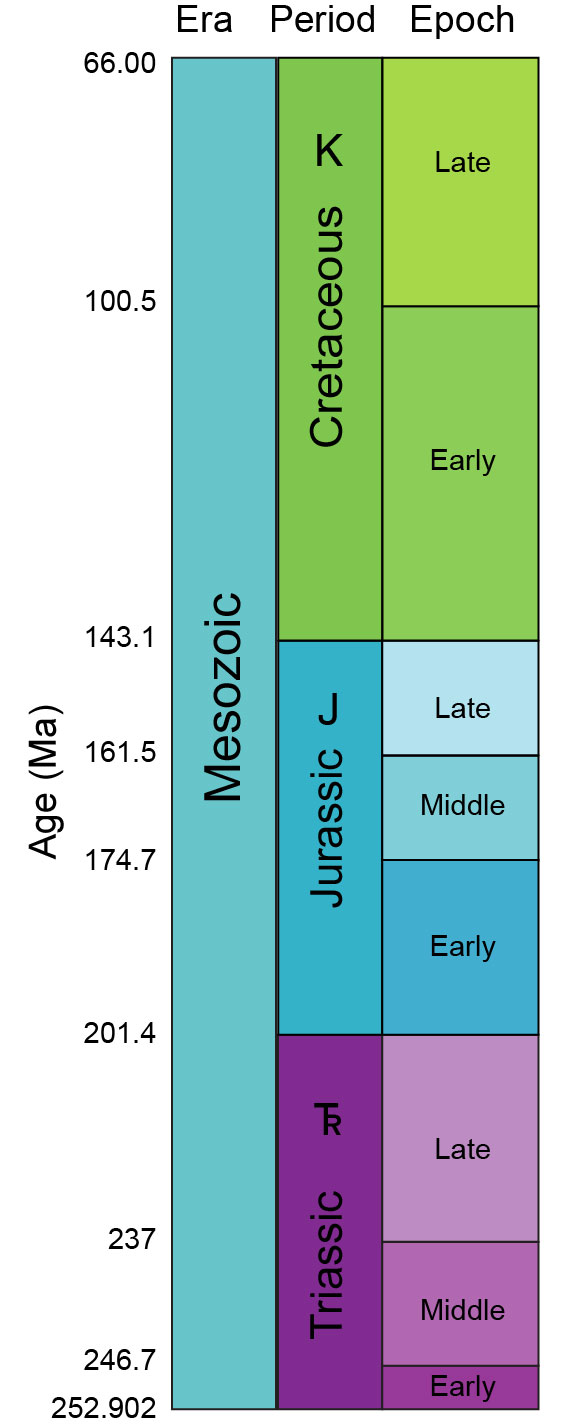
Mesozoic Era (252-66.0 Ma)
The Age of Reptiles: Diversity builds back on land and sea. Rise of many groups of modern forms, including:
modern insects; modern-style crustaceans and mollusks; advanced bony fish; modern-style amphibians;
early mammals (which become very diverse at small body sizes);
birds and other feathered dinosaurs; flowering plants (by mid-Mesozoic). Nearly all major terrestrial roles are in place by the 200 Ma,
but the players are different than those of today: dominant large terrestrial
and marine animals are all reptiles.
The Triassic-Jurassic Mass Extinction: A huge volcanic episode, triggered by the rifting of what is now the Central Atlantic, repeats on a slightly smaller scale the devastation of the Permo-Triassic extinction. Many marine and terrestrial groups die out; in particular, the loss of the once-dominant stem-members of the crocodile lineage and stem-mammals opened up opportunities for the dinosaurs to radiate into their diverse forms.
The Mid-Mesozoic Marine Revolution: In the marine realm, mid-Mesozoic shift from communities dominated by motionless attached animals to ones of modern style, dominated by moving mollusks, crustaceans, fish, etc.
The Cretaceous Terrestrial Revolution: Rise and diversification of more modern mammals, advanced insects, the newly-evolved flowering plants, and other small-bodied organisms during middle of Cretaceous.
Mid-Cretaceous Hothouse: Development of circum-Equatorial current allows for extremely high temperatures worldwide: hot, hot water gets very salty, sinks to ocean floor, and heats the water above.
Death From Above: At 66.0 Ma, an asteroid approximately 10-15 km diameter struck the Earth in what is now the Yucatan Peninsula of Mexico. The devastation brought by this blast (including major pulse of heat from re-entering debris, impact "winter" causing freezing temperatures and collapse of photosynthesis for weeks or months, and greenhouse "summer" afterwards by high levels of carbon dioxide released), on top of other environmental changes already happening, brought a mass extinction that ended the Age of Reptiles.
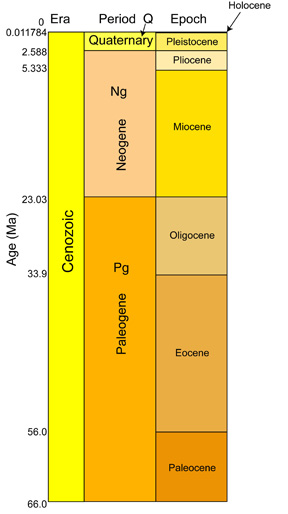
Cenozoic Era (66.0 Ma - now)
Age of Mammals: Surviving forms take over abandoned ecological niches: for example, most groups of large reptiles on land and sea are replaced by mammal groups. Diversity builds back up in land and sea.
Rifting of Antarctica from South America and Australasia shifts the world into an icehouse climate. This promotes the spread of grasslands as a new biome. These are followed by meadowland communities.
Turning Down the Thermostat: Development of a circum-Antarctic current produced chilling effects: cold, cold water sinks to the ocean floor, spreads about, and chills ocean above it. Later (about 7 Ma) rise of the Himalayan Mountains produces excessive erosion, which scrubs much carbon dioxide out the atmosphere, reducing greenhouse gases and cooling and drying the world yet more. During last 2.588 Ma the Quaternary Ice Ages: advance and retreat of glaciers.
Origins of Humanity: Rise of plains-dwelling primates as part of expansion of grasslands in Africa about 7 Ma. Diversification leads to rise of anatomically modern Homo sapiens by ~190 ka, behaviorally modern humans by ~70-60 ka, which then spread to every habitable part of the globe. Agriculture by ~10 ka: humans regionally begin to dominate their ecosystems.
Or, for The Simpsons version of this:
(Or the story backwards, courtesy of Guinness):
More seriously, PBS Eons overviews of Earth History:
Here's an 11 minute view of the history of the Earth at a constant time rate:
